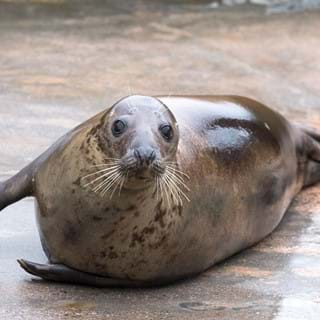Grey Seals
We have nine resident Grey Seals who call the Cornish Seal Sanctuary home.
All our residents have been given a permanent home at the sanctuary due to various injuries and conditions which sadly mean they wouldn’t survive in the wild.
We provide a safe haven for our residents, with regular enrichment and ongoing care from our specialist teams.
We’d love to introduce you them all...
Meet Sheba, Yulelogs, Marlin and many more of our Grey Seal residents and hear their rescue stories. Learn all about their characters and why they now have a permanent home here at the Sanctuary. Discover how Grey Seals survive in the wild and how the team at the Cornish Seal Sanctuary rescue over 70 injured or abandoned Grey Seals every year from around the Cornish Coast.

Banana
Banana was rescued on 24th August 2018 from Trevellas Cove, Cornwall.
She was around eight months old at the time and was malnourished with bite wounds to her flippers, she was also suffering from parasitic pneumonia.
After her recovery and rehabilitation Banana was all set to be released. However, at her release Banana was reluctant to leave her keepers side and even fell asleep on the beach. As this left her vulnerable to disturbance from the public, it was decided that Banana would return to the sanctuary with a view to the teams trying again the following day.
Banana was successfully released the next day but sadly re-stranded herself after three days.
After once again returning to the Sanctuary, it became apparent that Banana was suffering from seizures and was displaying unique personality traits meaning that she just wouldn’t survive in the wild. Our vets suspect that Banana may have congenital brain issues and have prescribed medication to control her seizures.
Banana is now a happy little seal, spending her days swimming and sunbathing with her fellow pool mates, who have learnt to tolerate her sometimes overzealous behaviour.

Aayla
Aayla was rescued from Bacton, Norfolk in January 2017 and taken to a local rehabilitation centre. She was malnourished and had a small injury on her right flipper.
After a vet’s investigation, an infection was found in the bones, requiring the amputation of some digits from her flipper.
In July 2018, Aayla was relocated to the Cornish Seal Sanctuary and now receives continuous care, including the application of ointment when the wound gets irritated during moulting season.
Always eager for her fishy reward, Aayla can often be seen racing the Animal Care team to the door when she sees them coming with buckets.
She loves causing mischief, pretending to be stuck in her toys for attention but knows exactly how to get out!

Atlanta
Affectionately known as Attie, Atlanta was rescued in 2001 from Oban, Scotland.
She was very small, and her eyes were damaged from gull attacks, resulting in blindness. These injuries meant that she wouldn't survive in the wild and would require lifelong care.
Attie is very enthusiastic during training and responds well to vocal cues, she’s a great listener and always comes over when you call her name. She’s very patient when getting her health checks done but will always let you know when she’s ready for her next fish!
She is a big fan of her alone time and will let everyone know when to leave her alone by slapping a flipper on her belly!

Marlin
Marlin was rescued from Sennen Cove in 2002 where he was found tangled up in fishing netting, which unfortunately is not uncommon for seals.
He was in the process of rehabilitation when he started losing weight, bumping into other seals and the side of the pool. After further investigation it was discovered that Marlin was completely blind. As there were no obvious injuries to his eyes, it is likely that he was born this way.
Marlin is quite a cheeky chap and loves stealing the hose and zooming around the pool with it.

Pumpkin
Pumpkin was rescued from Guernsey in 2011. He had a persistent urinary infection, which was later diagnosed as being caused by kidney stones. Unfortunately, this means he cannot be released into the wild and requires lifelong medication.
Despite his health challenges, Pumpkin is full of energy and his playful nature often lands him in trouble with his pool mates!
He loves enrichment activities, especially playing with his favourite orange buoyancy ring and floating on his surfboard.

Sheba
Sheba is our oldest resident; she was rescued in Cornwall back in 1974, making her one of the oldest seals in captivity in the UK.
Sheba was suffering from a nasty infection in both eyes which left her partially sighted, a problem that is exacerbated in bright sunshine and during her moult, when stray fur can aggravate her condition.
She is a stubborn old girl but a total sweetie at heart. She is still learning new skills and how to interact with new toys, her favourite is the orange squeaky ball, which is always a challenge for the Animal Care team to retrieve!

Willow
Willow’s journey began in 2014 when she was rescued from Donna Nook in Lincolnshire, after being separated from her mum.
She was in poor condition, suffering from severe hair loss, lethargy, and lacerations on her left side. Although she started rehabilitation with a view to being released, blood tests revealed she had an under-active thyroid, requiring lifelong treatment. As a result, Willow found a permanent home here at Gweek with our resident seals.
Willow is one of our most clever and mischievous seals! She’s always the first to solve a new toy and quick to push others aside when fish are involved. She has a particular love for feed balls and ice mountains.

Jinx
Jinx was rescued as a pup on 21st April 2017 from Godrevy, Cornwall. She was dehydrated, malnourished and displaying signs of anaemia.
After lots of investigation, it was later discovered that Jinx had a seal version of irritable bowel syndrome and would need to be on medication for the rest of her life. This condition meant that she would be offered a permanent home at the Sanctuary and become one of our lovely resident seals.
Jinx is a real foodie and loves her fish, especially mackerel and herring! She is famously known for her sports predictions, even though she may not have the best track record!
Her favourite activities are sunbathing and having her tummy tickled!

Yulelogs
Yulelogs (affectionately known as Logs) was rescued back in 1989 by a marine park in the North of England.
When the park closed down, Yulelogs was released back into the wild. However, after such a long time in captivity, he had no idea how to feed himself and was too familiar with humans.
Three months after his release Yulelogs was re-rescued by the RSPCA after they received calls from concerned members of the public saying that he had been chasing people on the beach with buckets, believing that they contained fish.
He only weighed 60kg instead of the standard 250kg. It was apparent he needed care, so he was given a permanent home here at the Sanctuary.
Logs, is obsessed with food, his favourite is squid or conger eels, he still splashes with excitement when he sees the team coming with their buckets!
Did you know?
- The scientific name for the Grey seal is Halichoerus grypus which means ‘hooked-nose sea-pig’!
- Grey seals will perform behaviours known as ‘bottling’ and ‘logging’. This is when they bob around vertically or horizontally in the water with just their head or back above the surface of the water. This is how they rest at sea while out foraging for days at a time.
- Grey seals are amazing divers and can stay under water for up to 40 - 45 minutes at a time! Unlike humans however, when grey seals dive they don’t take a big breath of air, they actually breath out most of the air in their lungs so it doesn’t make them float. Instead, they have specially adapted circulation and respiratory systems that allow them to hold lots of oxygen in their blood and muscles!
- Scent is really important to grey seals. They will sometimes greet each other by sniffing and mothers also identify their pups by smelling them. They are also one of the few animals that are able to smell underwater!
- The fur coat of grey seals is different patterns for males and females, males are darker and a more solid colour all over, whereas females have a steely grey coloured back and a mottled creamy colour belly.
- Each grey seal has a unique pattern in its fur which remains the same for their entire life.

